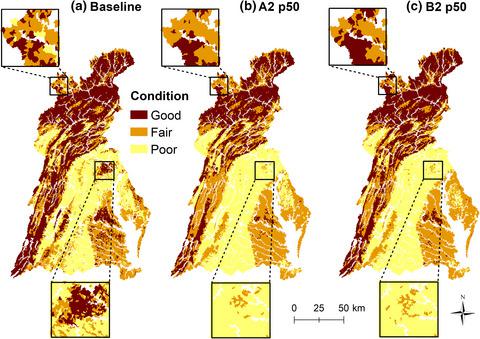当前位置:
X-MOL 学术
›
Glob. Change Biol.
›
论文详情
Our official English website, www.x-mol.net, welcomes your feedback! (Note: you will need to create a separate account there.)
Disentangling the potential effects of land-use and climate change on stream conditions.
Global Change Biology ( IF 11.6 ) Pub Date : 2020-01-19 , DOI: 10.1111/gcb.14961 Kelly O Maloney 1 , Kevin P Krause 1 , Claire Buchanan 2 , Lauren E Hay 3 , Gregory J McCabe 3 , Zachary M Smith 2 , Terry L Sohl 4 , John A Young 1
Global Change Biology ( IF 11.6 ) Pub Date : 2020-01-19 , DOI: 10.1111/gcb.14961 Kelly O Maloney 1 , Kevin P Krause 1 , Claire Buchanan 2 , Lauren E Hay 3 , Gregory J McCabe 3 , Zachary M Smith 2 , Terry L Sohl 4 , John A Young 1
Affiliation

|
Land-use and climate change are significantly affecting stream ecosystems, yet understanding of their long-term impacts is hindered by the few studies that have simultaneously investigated their interaction and high variability among future projections. We modeled possible effects of a suite of 2030, 2060, and 2090 land-use and climate scenarios on the condition of 70,772 small streams in the Chesapeake Bay watershed, United States. The Chesapeake Basin-wide Index of Biotic Integrity, a benthic macroinvertebrate multimetric index, was used to represent stream condition. Land-use scenarios included four Special Report on Emissions Scenarios (A1B, A2, B1, and B2) representing a range of potential landscape futures. Future climate scenarios included quartiles of future climate changes from downscaled Coupled Model Intercomparison Project - Phase 5 (CMIP5) and a watershed-wide uniform scenario (Lynch2016). We employed random forests analysis to model individual and combined effects of land-use and climate change on stream conditions. Individual scenarios suggest that by 2090, watershed-wide conditions may exhibit anywhere from large degradations (e.g., scenarios A1B, A2, and the CMIP5 25th percentile) to small degradations (e.g., scenarios B1, B2, and Lynch2016). Combined land-use and climate change scenarios highlighted their interaction and predicted, by 2090, watershed-wide degradation in 16.2% (A2 CMIP5 25th percentile) to 1.0% (B2 Lynch2016) of stream kilometers. A goal for the Chesapeake Bay watershed is to restore 10% of stream kilometers over a 2008 baseline; our results suggest meeting and sustaining this goal until 2090 may require improvement in 11.0%-26.2% of stream kilometers, dependent on land-use and climate scenario. These results highlight inherent variability among scenarios and the resultant uncertainty of predicted conditions, which reinforces the need to incorporate multiple scenarios of both land-use (e.g., development, agriculture, etc.) and climate change in future studies to encapsulate the range of potential future conditions.
中文翻译:

理清土地利用和气候变化对河流条件的潜在影响。
土地利用和气候变化正在显着影响河流生态系统,但同时调查它们之间的相互作用和未来预测的高度可变性的研究却阻碍了对其长期影响的理解。我们以美国切萨皮克湾流域 70,772 条小溪的状况为基础,对 2030 年、2060 年和 2090 年一系列土地利用和气候情景可能产生的影响进行了建模。切萨皮克盆地生物完整性指数(一种底栖大型无脊椎动物多指标指数)用于表示河流状况。土地利用情景包括四份排放情景特别报告(A1B、A2、B1 和 B2),代表一系列潜在的景观未来。未来气候情景包括来自缩小规模的耦合模型比对项目 - 第 5 阶段 (CMIP5) 的未来气候变化的四分位数和全流域统一情景 (Lynch2016)。我们采用随机森林分析来模拟土地利用和气候变化对河流条件的单独影响和综合影响。个别情景表明,到 2090 年,流域范围内的条件可能会表现出从大幅退化(例如,情景 A1B、A2 和 CMIP5 第 25 个百分位数)到小幅退化(例如,情景 B1、B2 和 Lynch2016)。土地利用和气候变化的综合情景强调了它们之间的相互作用,并预测到 2090 年,流域范围内的河流退化将减少 16.2%(A2 CMIP5 第 25 个百分位数)至 1.0%(B2 Lynch2016)。切萨皮克湾流域的目标是在 2008 年基线的基础上恢复 10% 的河流公里数;我们的结果表明,要在 2090 年之前实现并维持这一目标,可能需要将河流公里数减少 11.0%-26.2%,具体取决于土地利用和气候情况。这些结果强调了情景之间固有的可变性以及由此产生的预测条件的不确定性,这强化了在未来研究中纳入土地利用(例如发展、农业等)和气候变化的多种情景的必要性,以概括潜在的范围未来的条件。
更新日期:2020-01-21
中文翻译:

理清土地利用和气候变化对河流条件的潜在影响。
土地利用和气候变化正在显着影响河流生态系统,但同时调查它们之间的相互作用和未来预测的高度可变性的研究却阻碍了对其长期影响的理解。我们以美国切萨皮克湾流域 70,772 条小溪的状况为基础,对 2030 年、2060 年和 2090 年一系列土地利用和气候情景可能产生的影响进行了建模。切萨皮克盆地生物完整性指数(一种底栖大型无脊椎动物多指标指数)用于表示河流状况。土地利用情景包括四份排放情景特别报告(A1B、A2、B1 和 B2),代表一系列潜在的景观未来。未来气候情景包括来自缩小规模的耦合模型比对项目 - 第 5 阶段 (CMIP5) 的未来气候变化的四分位数和全流域统一情景 (Lynch2016)。我们采用随机森林分析来模拟土地利用和气候变化对河流条件的单独影响和综合影响。个别情景表明,到 2090 年,流域范围内的条件可能会表现出从大幅退化(例如,情景 A1B、A2 和 CMIP5 第 25 个百分位数)到小幅退化(例如,情景 B1、B2 和 Lynch2016)。土地利用和气候变化的综合情景强调了它们之间的相互作用,并预测到 2090 年,流域范围内的河流退化将减少 16.2%(A2 CMIP5 第 25 个百分位数)至 1.0%(B2 Lynch2016)。切萨皮克湾流域的目标是在 2008 年基线的基础上恢复 10% 的河流公里数;我们的结果表明,要在 2090 年之前实现并维持这一目标,可能需要将河流公里数减少 11.0%-26.2%,具体取决于土地利用和气候情况。这些结果强调了情景之间固有的可变性以及由此产生的预测条件的不确定性,这强化了在未来研究中纳入土地利用(例如发展、农业等)和气候变化的多种情景的必要性,以概括潜在的范围未来的条件。


























 京公网安备 11010802027423号
京公网安备 11010802027423号